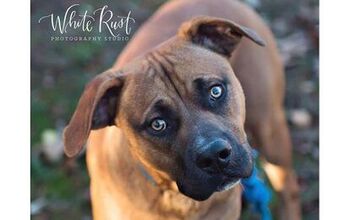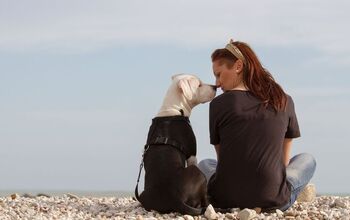Rhodesian Labrador


About Rhodesian Labrador
The Rhodesian Labrador brings the gentle, loving nature of the Labrador Retriever together with the determined, headstrong personality of a Rhodesian Ridgeback to produce a loyal, affectionate family dog with protective tendencies and a love of play. These hybrids are versatile, do great as family pets and working dogs, and fit in various lifestyles with ease. Honestly, it’s easy to see why this hybrid is quickly gaining popularity!
Because he may have inherited a bit of a stubborn streak, this big boy is best suited for experienced pet owners who know how to assume the role of pack leader. His high energy levels make him perfect for families with kids who can engage with him on a regular basis to keep him from becoming bored and destructive. Provided that their activity needs are met, Rhodesian Labradors are a good choice for both an apartment and a house with a backyard. Curious to learn more about this rare breed and see if it’s a good match for your family? Read on to meet the stunning Rhodesian Labrador!
The Rhodesian Labrador is a mix of Labrador Retriever and Rhodesian Ridgeback.
As it is usually the case with hybrid breeds and designer dogs, the Rhodesian Labrador is somewhat of a mystery. Apart from the genetic makeup, there’s not much we do know about this particular mix of breeds! This is especially true for the nitty gritty of the breed’s development. There have been no breeders that claim Rhodesian Labrador as their creation, so there’s no precise information about the breed’s origin. The best guess we can have is that this large, gorgeous dog shares his story with much of his fellow designer dogs.
This would mean that the Rhodesian Ridgeback and Labrador Retriever mix was first developed as a breed sometime in the last 15 to 20 years when the designer dog trend reached its peak. Of course, that’s not to say that there haven’t been any Rhodesian Ridgeback and Labrador Retriever mix litters before that- it’s just that they weren’t planned or thought of as a unique breed. Similarly, we can deduce that it’s highly likely that the Rhodesian Labrador had its start in the United States, not unlike most designer breeds.
The Rhodesian Labrador is a relatively new breed of designer dog and while his history may be short, his ancestry dates back hundreds of years. The Labrador Retriever originated in 19th century Newfoundland where he was used by fishermen to haul nets, ropes and pull in fish while images of the Rhodesian Ridgeback date back to the 18th century when the dog was first developed in what is now Zimbabwe and known as the African lion hound because of his ability to keep a lion at bay while awaiting his master’s arrival.
As the breed’s name suggests, Rhodesian Labrador is a mix between a Rhodesian Ridgeback and a Labrador Retriever. This is a 50-50 percent mix of two purebreds, as parents of these hybrids always belong to two different breeds. As a result, the majority of Rhodesian Labradors are first generation hybrids, a type of crossbreed many praise as healthy and robust. However, at the same time, F1 mixes are also quite unpredictable- you can never know which of the parents will be more influential in the mix. For instance, some of the puppies in the litter could take up after the Lab parent and others could look more like a Rhodesian. It’s all genetic lottery- and part of the designer dogs charm. Each Rhodesian Labrador is one of a kind, both in terms of his personality and appearance.
Naturally, some people prefer uniformity and want a designer dog that has a higher percentage of one breed in the mix, and that’s why multigenerational crossbreeding is fairly common. This would involve breeding a Rhodesian Labrador to an unrelated Labrador Retriever or a Rhodesian Ridgeback, depending on which of the breeds you want to be more dominant. Similarly, there are second generation Rhodesian Labradors, whose both parents are Rhodesian Labradors rather than purebred dogs. However, as this is still a rare and recent breed, these types of mixes are still not that easy to come across.
Because he is a designer or mixed breed dog, the Rhodesian Labrador cannot join the American Kennel Club’s (AKC) roster of purebreds. His parents however, have both achieved AKC status; the Labrador retriever was admitted to the club’s “sporting” group back in 1917 and is described as active, friendly and outgoing. The Rhodesian Ridgeback was made a member of the club’s “hound” group in 1955 and is considered dignified, even-tempered and affectionate.
The Rhodesian Labrador is a large-sized dog that comes from two breeds that absolutely love to over-eat. Do not plan to free-feed your dog, but space his meals out over the course of the day and ensure the kibble size is scaled for a large dog (to prevent too fast gobbling) and geared specifically to his age and activity level. Ensure it is a top quality food without fillers such as carbs and grains that will only encourage over-eating in order to make him feel full. Foods should indicate “meat” as a first ingredient and because he may be prone to hip dysplasia and joint issues, kibble that includes glucosamine is a good option. Because bloat may be an issue with this dog, do not plan his exercise around a meal period.
The Rhodesian Labrador prefers to be inside in the company of his family.
The Rhodesian Labrador is a large dog who can have a will of his own when it comes to training, so an experienced pet owner who is familiar with large breed dogs or a professional trainer, would be best. Obedience and socialization are imperative to bringing out the best in this dog given his natural instinct to be cautious around strangers and act aggressively towards other animals if not taught otherwise. Rhodesian Ridgebacks are known to shut down when disciplined too harshly so although he will require firm, consistent training, it should always be rewards based, with positive reinforcement and lots of treats, pats and verbal praise to get the results you are looking for.
The Rhodesian Labrador is a large sized breed that will reach a weight of 75-80 pounds when fully grown.
The Rhodesian Labrador comes from two breeds that are known for being highly loyal to their owners, easy-going and affectionate with family members including children. This dog bonds closely with his pack and in spite of his size, is not considered an outdoor dog; he much prefers to be inside in the company of his family. He does have a strong, protective instinct and while not aggressive or prone to barking, he is wary of strangers and will tend to “posture” to intimidate. His hound instincts can make him inclined to chase small animals and this, coupled with a predisposition to act out towards other dogs and even with early socialization, this can be difficult to wean him from.
While Rhodesian Labrador’s have no known health issues, prospective owners should be aware of the types of ailments to which their dog may be genetically predisposed. In the case of both the Labrador retriever and the Rhodesian Ridgeback, hip and elbow dysplasia can become a problem. The deep-chested Ridgeback may also pass along gastro-intestinal issues such as bloat as well as dermoid sinus, a ridge that runs along their spinal column and can require surgery.
The Rhodesian Labrador has a life expectancy of 10-12 years.
In spite of his large size, Rhodesian Labradors don’t need excessive exercise beyond a daily walk and some active playtime in the backyard. Owners must however keep in mind that excess weight can create mobility issues for larger dogs as they age so it’s important to keep his diet in check and develop a regular routine that will keep him up and moving to tone his muscles, maintain his weight and keep him mentally stimulated. Off-leash dog parks may not be the best choice for this dog as hounds are known to be unreliable off-leash and tend to chase or wander easily. As with every breed, inactivity leads to boredom which can lead to mischief and destructive behavior – chewing is particularly problematic with Ridgebacks.
Rhodesian Labradors are highly loyal to their owners, easy-going, and affectionate with family members including children.
Also known as a Labradesian, the Rhodesian Labrador does not qualify to be recognized by the AKC however he is a member of the Dog Registry of America, Inc. (DRA).
Rhodesian Labradors should be considered moderate shedding dogs. The parent breeds include Labrador retrievers who have a thick double coat and are known to be heavy seasonal shedders as well as the minimally shedding Rhodesian Ridgeback that has a thin, short coat. Either coat can be inherited by this mixed breed dog, and adopting when he is more mature and you can inspect his coat may help distinguish whether he will be a moderate or minimal shedder. Either way, his coat will require weekly brushing to keep it looking its best with bathing only as needed. Professional grooming services won’t be needed unless you need help clipping his nails or brushing his teeth and because he will most certainly inherit floppy ears, he may be prone to ear infections so weekly inspection and cleaning should become routine.
Rhodesian Labrador puppies are highly energetic and love active play however owners need to ensure it is in a safely enclosed space (fully fenced yard) or on a suitable leash or lead. While young, the hound DNA in your little guy is strong and the urge to chase anything and everything can put him in harm’s way. Even with training, this can be a work in progress as he grows into adulthood. Because he comes from breeds known to be prone to joint issues, walks and exercise should be short and frequent to prevent over-exertion of little legs that might lead to problems later in life.
Photo credit: wabang70/Bigstock; Loco Lobo/Bigstock; Jarrycz/Bigstock

Sharing space with three seriously judgy Schnoodles and a feline who prefers to be left alone. #LivingMyBestLife
More by Mary Simpson
























